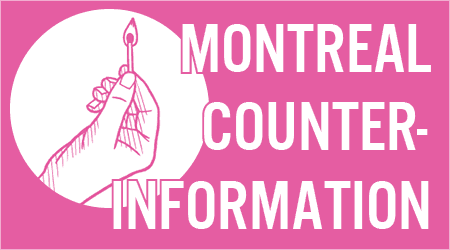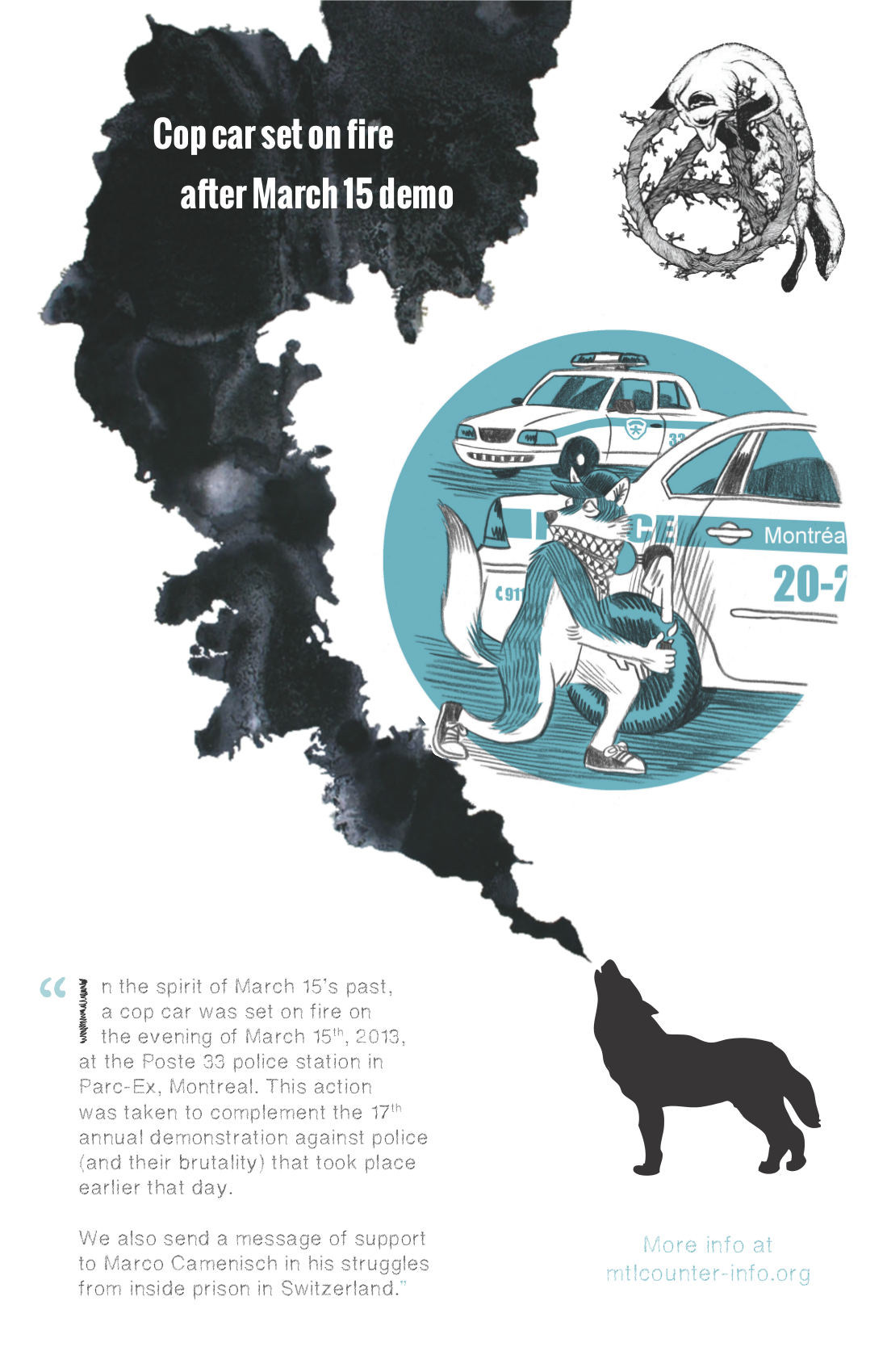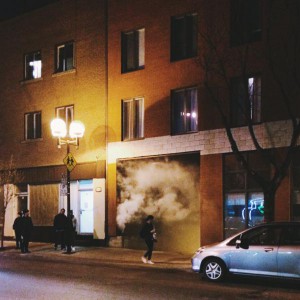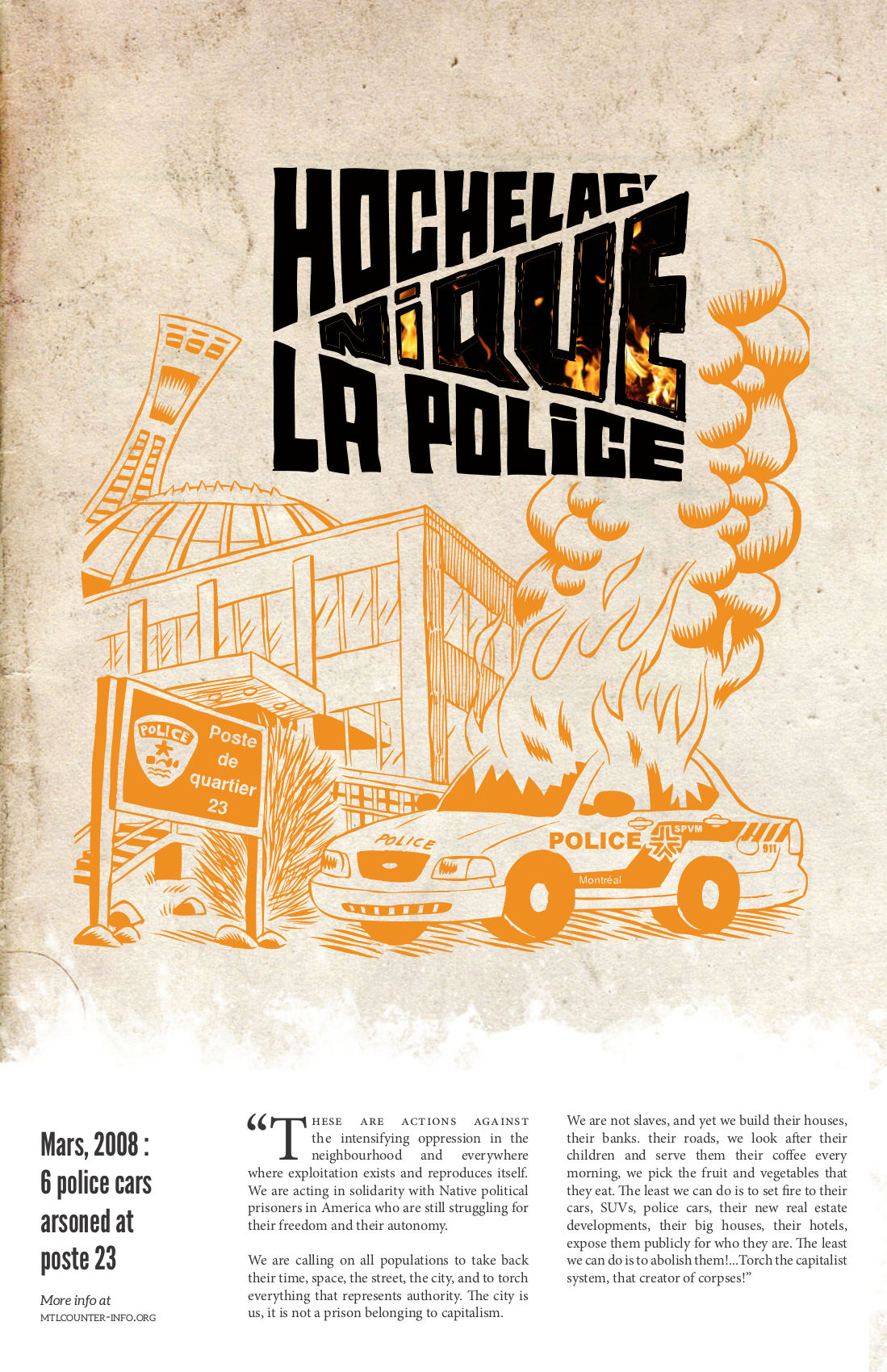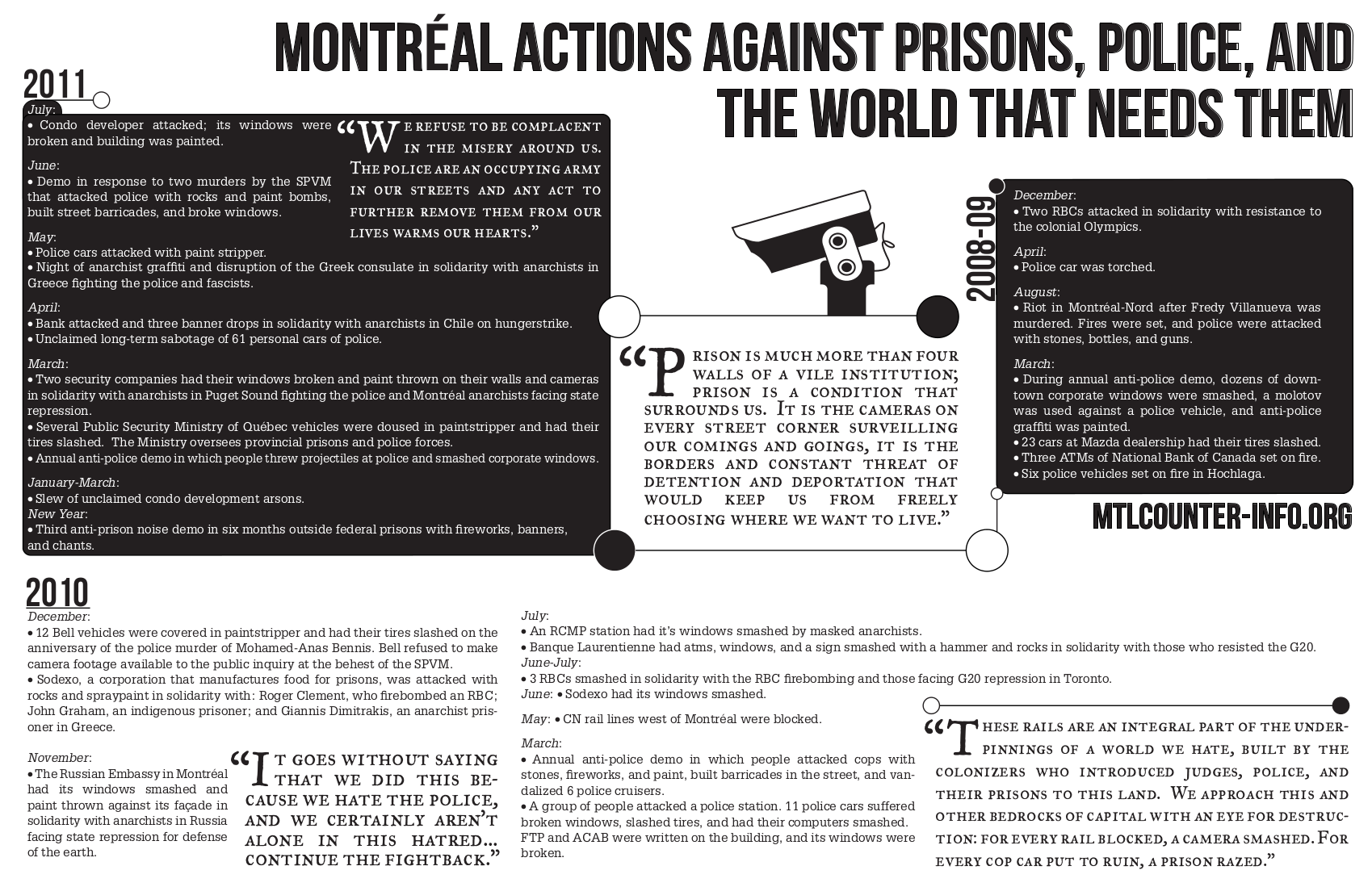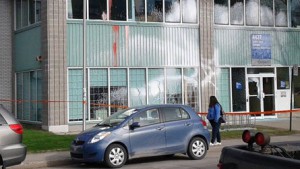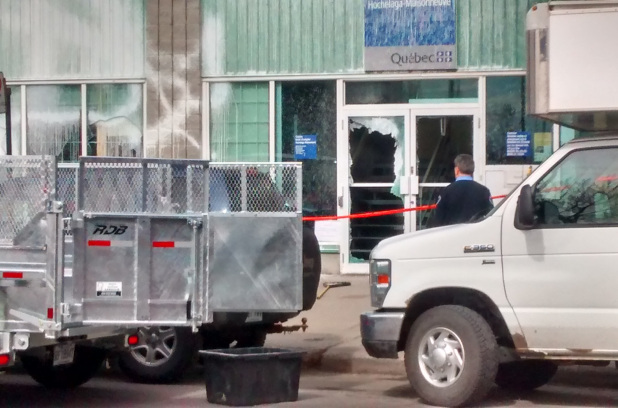From our enemies – Global News, 01/25/2015
In a brazen attempt to vandalize several businesses at around midnight on Saturday, a group of individuals wearing ski masks broke the windows of four businesses located on Notre-Dame Street in St-Henri.
Dressed all in black, the vandals damaged storefronts as seen in a security video obtained by Global News.
The damage to Jesse Bowden’s shop, Campanelli, was just shy of $8000 in glass alone.
“We’ve never seen or witnessed a group like this, at this time, with so many witnesses, with weapons running en masse in the middle of the street, this isn’t a war zone” says the concerned business owner.
There is speculation that this is a result of growing anti-gentrification sentiment from some people in the community.
According to another local business owner, Corey Shapiro, “It’s no longer vandalism, it’s causing terror to people who live in the area.”
Two of his businesses were attacked over the weekend, businesses he says help the neighbourhood to thrive.
This is not the first time attacks like this have happened in the area.
According to a barber named Thaddeus who works at Shapiro’s barbershop, “We’ve been , and the night before, there was an incident outside Juicyyy lab, so obviously there’s a bunch of people who don’t like what were doing.”
Vandal rampage targets shops on Notre Dame in St. Henri
From our enemies – CTV, 01/25/2015
Police are investigating after at least eight stores in St-Henri were vandalized at 11:30 p.m Saturday night as a group of masked individuals wearing hoods went on a violent destructive rampage on Notre Dame St. W. near Delinelle St. in the Southwest borough.
The masked vandals came equipped to smash windows. “There were about 10 guys all dressed in black and they came with pool balls and crow bars and broke the windows and 30 minutes later everything was broken everywhere,” said Vincent Powell.
Several witnesses called 9-1-1, but when the suspects fled the scene before police arrived.
The Saturday night attacks came one night after an opening night party for a juice bar was targeted by what appeared to be the same attackers. Entrepreneur Corey Shapiro said that smoke bombs were tossed into his newly-opened juice bar Friday. When he went out to look at what was going on, he was hit in the face by pepper spray.
“I ran outside to see what the story was and I got pepper sprayed by people dressed all in black with masks, who had made a strategic attack on a crowd of a couple of hundred people,” he said. “This was an attack potentially endangering people’s lives.”
Jesse Bowden, who is a co-owner of the Campanelli boutique, was on hand Sunday evaluating the damage. He told CTV Montreal that there has been a history of such attacks on the strip.
“They came through about eight months ago spray painting the whole front of the storeface and a group then put out a manifesto on a website saying it was a politically motivated attack to stop the gentrification of this neighbourhood. These are people who are unhappy with the neighbourhood has changed, but the people that are changing it are all from this neighbourhood,” he said.
From our enemies – Montreal Gazette, 01/25/2015
Business owners in St-Henri are calling on the city of Montreal to take action to stop what some are calling an organized campaign of anti-gentrification “terrorism” in the Sud-Ouest borough neighbourhood.
For several months now, graffiti denouncing gentrification has been appearing on walls and windows of businesses along a stretch of Notre-Dame St. W., a formerly rundown area that has been attracting business catering to higher income residents in recent years.
Last Friday evening, several masked individuals dressed all in black threw a smoke bomb into a crowd celebrating the opening of a high-end juice bar on Notre-Dame St. W. near St-Philippe St. One member of the group also pepper-sprayed the owner of that business, Corey Shapiro, in the face.
And early Sunday, a similarly dressed group was seen breaking windows of several businesses along Notre-Dame St. W. with crowbars and billiard balls. The vandalism was witnessed by many, as it happened shortly after midnight, when bar and restaurant patrons were still out in numbers.
“I’m asking people to stop,” Shapiro said in an interview with the Montreal Gazette on Tuesday. “I’m asking the city to come in and to stop this. It is no longer vandalism. It is terrorism. Somebody is terrorizing the neighbourhood.”
Montreal police say it is too early to say whether the two incidents are linked, but police spokesperson Sgt. Raphaël Bergeron acknowledged there have been a number of similar incidents in that area in recent months.
New condominiums along the Lachine Canal and the opening of the nearby Glen site of the McGill University Health Centre have been attracting wealthier residents to the area in recent years, and not everyone is happy about it.
In an anonymous article posted last November in anarchistnews.org — a website that describes itself as a non-sectarian source for news about and of concern to anarchists — “some anarchists” claimed responsibility for vandalizing several new businesses along Notre-Dame St. W.
The article describes with derision the “new foodie restaurants, high-end boutiques, art galleries and ‘drinkeries’ catering to the residents of all the canal-side condos, replacing the dollar stores and flea markets.” The post goes on to say, “we decided to render some of our disgust with gentrification by vandalizing two such examples with fire extinguishers filled with paint.”
One of those businesses named as targets in the post was Shapiro’s barbershop, Notorious, and another was Campanelli, a coffee shop and clothing boutique. Both were again attacked in last weekend’s vandalism, along with other nearby businesses.
Shapiro also owns an eyewear store called Vintage Frames Company on Notre-Dame St. W. and a half-dozen modest residential properties in St-Henri. But he says he is not in the business of pushing anyone out of the neighbourhood.
He said most of the people in the neighbourhood are happy to see new businesses.
“Some people aren’t. But the people who aren’t, in most cases, are targeting their unhappiness at the wrong people. I’m not responsible for wages or income. I’m not responsible for the world’s jobs. I’m responsible for the wages, income and safety of the people I employ.”
Shapiro admits he may be a particular target for criticism from anti-gentrification activists because he wears gold chains and drives a gold BMW. He says he got the car for free in a marketing deal with BMW and the gold theme runs through his businesses, but he is “not a rich man.”
He seems frustrated when asked how he proposes that the city solve the problem. He is a businessman who deals in eyewear, juice and hair, not a politician, he says.
“I don’t have the solution because this is not my forté. I mean, if the mayor comes to me and says that to solve this problem, he needs a powerful pair of glasses, I’m your guy. Or if he feels he needs a boost in the morning, I got him on the juice. Or if he feels people don’t like him or don’t take him seriously because he has a bad haircut, I’m the guy to cut his hair. But I’m not the guy to plan or tell anybody how to fix this.”
The mayor of the Sud-Ouest borough, Benoit Dorais, said he is already working on some potential solutions. First, he condemned the vandalism publicly and asked Montreal police to increase their surveillance of the St-Henri area.
But he also acknowledged that there is some resentment of the neighbourhood’s new, middle and upper-middle class residents and the businesses that cater to them.
More than half of the Sud-Ouest borough’s residents still live on incomes that fall under the poverty line, he said, and businesses that cater to that clientele are not actually being pushed out.
From Contra-info
Note of Contra Info: We publish this communiqué as we received, hoping that the insects did not suffer retaliation
On the morning of April 24th, 2015, we released hundreds of crickets in the Macdonald Engineering Building of McGill University, with the goal that they would spread and disrupt operations in multiple labs involved in technological development for the military. The campaign Demilitarize McGill has published extensive research on these labs’ activities, which range from military-funded explosives experiments to development of algorithms for control of social networks in collaboration with North American intelligence agencies. This action was simple to pull off, requiring no special skills or resources.
The Shock Wave Physics Group, the Aerospace Mechatronics Lab, the Network Dynamics Lab and their collaborators help spread death and entrench state control around the world, concretely opposing struggles for freedom. We invite others to escalate direct action against them and other labs. We act in solidarity with Anti-Imperialist Action and everyone else engaged in the fight to demilitarize McGill University.
– anarchists
Our enemies – journal de montreal, 01/05/2015
The local employment centre of Hochelaga-Maisonneuve was vandalized, over the night of Thursday to Friday, in Montreal, when white and red paint was thrown on the buildings façade and the windows were broken.
A passerby called 911 around 5:40 am to communicate the dammages to the building on rue De Rouen. Upon arriving at the location, police also noticed the interior had been ransacked, affirms the spokesperson of the SPVM, Jean-Pierre Brabant.
The service of judicial identity of the SPVM were dispatched to try to obtain evidence. It seems that no camera surveils the location.
May 1st – June 7th
The entire month of May (and part of June) is the Festival of Anarchy, with diverse anarchist-themed events occurring at different venues all over the island of Montreal. The Festival of Anarchy is organized as part of the Montreal Anarchist Bookfair (May 23-24, 2015) and is the largest anarchist event in North America. See the full schedule the anarchist bookfair website.
From Group de soutien
Last Wednesday, April 15th, my friend got arrested at UQAM. Security agents followed him in the hallways. They called the cops who made the arrest. He spent the night at the Operational Center. He was supposed to get released at the municipal court but the judge moved the inquiry to the next day. He spent that night at the Rivière-des-Prairies male prison in northern Montreal. The next day; Friday the 17th, we organized a picket in support at the municipal court and waited all day for his turn. We were about 30 people. After the inquiry, the judge denied bail before trial. Until then, he will serve time without trial at Rivière-des-Prairies. The judge’s main argument is that if he had freed our friend, it would damage public opinion and that the population would lose faith into the justice system. He also spoke of the importance to preserve the public’s trust into the management of that justice system; in concern to a «well-informed public», he said. He was talking about the people who read the newspapers and watch the news on television every night, basically, thus an hymn to the mass media.
Contrary to what the judge stated, our friend is paying the price alone for a movement already strongly repressed, meaning that his imprisonment is nothing but political.
Facing the political and judicial violence ongoing at UQAM in the context of the injunction against strike mandates, and the relentless profiling that students and their allies are being put through, we can only revolt. Our friend is clearly being used as an example in order to strike fear and shut down the voices of dissent. We do not believe in the justice system but it is easy to feel lonely and powerless against such hegemonic power. We acknowledge the fact that we are in a “war” were two sides with opposite and irreconcilable interests are fighting each other, thus meaning that we have to organize to protect ourselves more so that we can stay dangerous while confronting the state and his minions. This is why masking ourselves is appropriate. Even if your friends and the security guards recognize you, it is still harder to do so with the surveillance camera that will be used to incriminate you.
Our friend is not a martyr, he is not a hero nor a leader; what happened to him could’ve happened to anyone of us.
That is why we are calling for active solidarity without dissociation or condemning of all the people criminalized by the State, at all time and in the context of the actual strike movement, may it be for the reason of disruptive actions, protests or facing injunctions. This solidarity expresses itself with a collective responsibility towards the well being of each and every one of us. Denouncing criminalization with protests or pickets, opposing targeted arrests and snitching, bringing legal, financial and moral support (letters, fundraisers, etc) and demanding the removal of charges, copwatching, taking care of the wounded, staying close together. Those are the basis of a resistance culture that we must nurture and develop. The legitimization of tendencies that advocate the less possible gain, are less dangerous and maintain a status quo that divide the movement and isolate radical thinking. We believe on the contrary that it is by the continuity of the movement, it’s expansion and intensification that we can aspire to a more just society. Police repression and it’s consequences on short, middle or long term is an attack with no common measure against this ongoing movement.
We won’t back down.
You can write support letters to our friend and leave them at L’Insoumise (the Montreal anarchist bookstore), at Café Aquin (in UQAM-Hubert Aquin Pavillion or at La Déferle (« anarchist social space » in Montreal).
You can also contribute to the fundraiser, write to us for more infos:
groupedesoutien@riseup.net
There will be a picket in front of the municipal court on April 29 at 9:30
AM.
All the prisoners are political prisoners!
Down to all the prisons!
On April 8th, a banner reading “Solidarité avec les prisonniers en grève de la faim en Grèce. Que vive l’anarchie (Solidarity with prisoners on hunger strike in Greece. Long live anarchy)” was dropped along with flyers bearing the following text:
Solidarity from Montreal
Today, we paid homage to those prisoners in Greece who are on hunger strike since March 2nd, 2015.
The governing political party in Greece since January 2015 is the radical leftist party Syriza, a party which promotes anticapitalist and antipatriarchal ideas. However, it is clear this party’s role in reality is to recuperate all social rebellion. Many anarchist prisoners, political prisoners, and social prisoners recognize this and live the consequences each day.
A hunger strike was thus called to demand, among other things, the abolition for several fascist laws and Type C prisons. Many comrades are experiencing severe health problems for their participation in the strike. These events show the true face of the ruling Left party, which continues to repress struggle.
Here are the demands of the prisoners on strike:
• Abolition of the antiterrorist law 187A and the law against illicit organisations 187
• Abolition of the increased severity for actions committed with facial characteristics disguised (“the mask law”)
• Abolition of maximum security prisons Type C
• Abolition of laws permitting the testing of DNA traces
• Access for expert witnesses of the accused to DNA-related evidence
• Abolition of DNA analysis of evidence containing a mix of more than two people’s DNA
• The immediate liberation of Savvas Xiros so that he may receive the medical treatment he requires.
Strength and courage to those in prison and on the run!
For the destruction of the state, capitalism, and all prisons.
Long live anarchy.
More information:
contrainfo.espiv.net
hunger-strike.espivblogs.net
www.non-fides.fr


